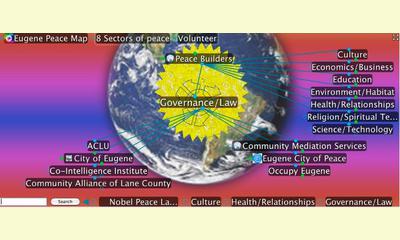|
|
A Peace Map for Eugene, Oregon (USA)
un articulo por David Hazen
The purpose of the Eugene Peace Map is to demonstrate that a culture of peace in Eugene is mainstream, tangible, and participant-friendly. I hope to accomplish four goals:

click on photo to enlarge
1. Define a city that satisfies needs for safety, prosperity, and quality of life in multiple sectors as having a culture of peace,
2. Recognize, measure and celebrate the culture of peace that already is in place,
3. Facilitate the increase of volunteerism,
4. Encourage research into best practices for meeting human needs.
The map is an online, interactive graphic display containing two basic elements:
1. a visual "family tree" of government and non-government organizations that individually and collectively promote a culture of peace
2. a series of measurements of Eugene's progress toward a culture of peace.
When you visit the map online, you will see a pattern of word boxes containing the names of ideas or organizations, linked with lines. Every time you click on any of the visible boxes, they move to the center of the map and display their relationships to other families of boxes. The central box will have any text information or links to relevant web pages displayed below the map in a secondary frame. There will be a "parent" box above the central, active word and "brother-sister" boxes on the right side. The most recently visited thoughts are across the bottom edge of the map, and permanent bookmark tabs line the top edge.
The map is a work in progress and is being constructed using TheBrain software, which is available as a free download of the Pro version, some features of which expire in 30 days. However, it is still usable and publishable on the web. The software automatically syncs to a mirror-image map on the web.
The background image can be anything you wish to use, and I built ours in Photoshop. The basic skeleton of the map is based on the 8 sectors of the Pathways to Peace peace wheel. We are currently preparing to gather information from all the organizations in Eugene that could possibly be on the map. I expect that when this map is complete, we will be including a major portion of the population of Eugene because the definition of a culture of peace does include everyone who is contributing in any way to human security as defined by the UN Development Program: economic, food, health, environment, education, community, personal or political security. I hope to have it finished and ready for public release on the International Day of Peace, September 21, 2012, in combination with a publicity campaign in the local media.
|








|
DISCUSSION
Pregunta(s) relacionada(s) al artículo :
How can culture of peace be developed at the municipal level?,
* * * * *
Comentario más reciente:
:
International Cities Choose Peace
J. Fred Arment
arment@internationalcitiesofpeace.org
International Cities of Peace, an association of global cities of peace, is using the U.N. Culture of Peace tenets as the guideline for forming initiatives. To date, thirty-one cities are part of the association. Some are grassroots organizations, others have the firm commitment by resolution or proclamation from the city council.
International Cities of Peace include the following:
• Dayton, Ohio, U.S.A.
• Eugene, Oregon, U.S.A.
• Unity Village, Missouri, U.S.A
• Coventry, England
• Bradford, England
• Guadalajara, Jalisco, Mexico
• Bukavu, Democratic Republic of Congo
• Mataki, Philippines
• Pathuthani, Thailand
• Fizi, Democratic Republic of Congo
• Lake County, California, U.S.A.
• Aba, Abia State, Nigeria
• Nagpur, India
• Reno, Nevada, U.S.A.
• Bujumbura, Burundi
• Mzuzu and Lilongwe, Malawi
• Tunis, Tunisia
• Tuolumne County, California, U.S.A.
• Bihac, Bosnia, Herzegovina
• Yaounde, Cameroon
• Freetown, Sierra Leone
• Nyala, Darfur, Sudan
• Bujumbura, Burundi
• Victoria, British Columbia, Canada
• Nakuru, Kenya
• Calgary, Alberta, Canada
• Kathmandu, Nepal
• Detroit, Michigan, U.S.A.
• Egg Harbor City, New Jersey, U.S.A.
• Warrake, Nigeria
• Kalamazoo, Michigan, U.S.A.
To start an initiative, go to the association's website for resources and tools.

|
|









